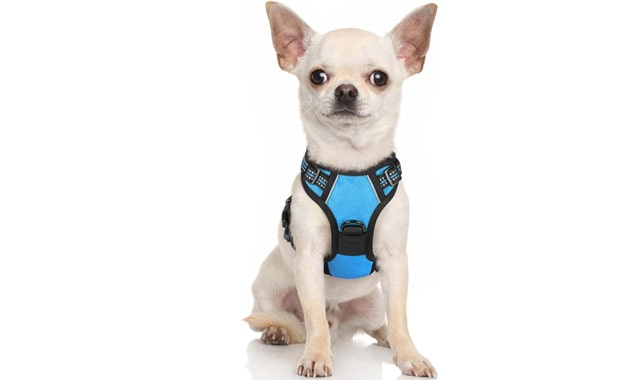Tips for Choosing Best No Escape Dog Harnesses
Walking and exercising your dog safely and comfortably requires finding the right no escape harness for their needs. With so many options on the market, it can be tricky to determine which harnesses truly live up to their “escape-proof” claims. Consider the following tips when shopping for the most secure, adjustable, and easy-to-use no escape dog harness for your pup.
Assess Your Dog’s Size, Build and Temperament
When selecting a no escape dog harness, your dog’s physique and personality are key factors. Lean, slender greyhounds or whippets need a different harness fit than stocky bulldogs or pugs. Hyperactive pullers require more control than relaxed older dogs content to amble. Before buying, accurately measure your dog around their chest and neck and consult sizing guides. Also consider their tolerance for pressure points, wiggling out of gear and pulling on leash. All this will help determine features like adjustability, security and control.
Look for Proper Fit and Adjustability
The right harness matches your dog’s proportions and doesn’t restrict movement. Make sure straps adjust for snugness while leaving room for comfort. Fixed one-strap designs often don’t accommodate many body types. Instead choose adjustable straps at the neck, chest and belly for a customized secure fit. They should tighten enough to prevent escape without pinching or rubbing. You should be able to fit two fingers between straps and your dog. Also ensure quick-release buckles or loops for conveniently taking the harness on and off.
Select Durable, Chew-Resistant Materials
Rambunctious dogs can damage flimsy harnesses, allowing them to break free. Choose rugged, chew-resistant materials like nylon webbing or neoprene padded with reinforcements at stress points. Thick padded straps add comfort and prevent chewing. Make sure hardware like buckles and D-rings are high-quality. Also inspect stitching that it’s reinforced and not easily frayed. Avoid thin elastic or velcro collars dogs can gnaw through. Pick a harness built to contain your dog’s strength and chewing tendencies.
Look for Secure Yet Comfortable Desig
An escape-proof harness keeps your dog safely contained without restricting movement or causing discomfort. H-style harnesses that cross the chest and wrap under the belly offer security while preserving mobility. Wide straps disperse pressure instead of pinching or chafing. Padding at the chest and underbelly prevents rubbing. Make sure the neck opening is large enough to avoid straining your dog’s head through. Also pick lightweight breathable materials, especially for warm climates or dogs who overheat. Escape-proof doesn’t have to mean uncomfortably constricting.
Get the Proper Features for Control
For powerful pullers, choose no escape harnesses designed to give you control without choking your dog. Front-clip harnesses redirect dogs back towards you if they lunge or pull. Some have dual front and back clips for added steering. Look for a sturdy handle to help restrain overeager dogs. Additional no-slip belts provide extra security. But avoid unnecessary restraints that severely limit your dog’s movement. The proper control features let you manage your dog’s behavior without unnecessary force or restriction.
Match the Harness to Your Dog’s Purpose
Factor in how your dog will use the no escape harness. Thicker padded harnesses suit lengthy walks or hikes. Lighter nylon designs work for quick trips and potty breaks. Bulky harnesses with more control features manage high-energy pullers. If your dog rides in the car, look for straps that won’t get tangled in seat belts. And make sure the harness evenly distributes force in case of sudden braking. Matching the harness to your dog’s lifestyle ensures safe, secure performance.
Balance Freedom of Movement with Escape Protection
Preventing escape doesn’t need to mean severely limiting your dog’s ability to move comfortably. Look for a harness with enough adjustability, flexibility and padding to allow good range of motion. But it still needs enough security features to live up to “no escape” claims. The most effective designs combine multi-point adjustability, reinforced stitching, control features and padding to strike the right balance. Try the harness on your dog and watch how they move to ensure unrestricted movement.
Supervise Your Dog at First
When first using a new no escape harness, keep a close eye on your dog. Check that all straps are properly tightened without pinching or rubbing. Watch how they move to ensure the harness doesn’t hinder mobility or comfort. Look for signs of chafing or attempts to wriggle free. It may take some adjustment to find the perfect fit. So monitor the harness in action before relying on it unsupervised during long walks or in open spaces. Proper fit and use takes some trial and error.
Pick Established Escape-Proof Brands
Stick with proven brands known for quality, security and safety. Trusted names like Kurgo, Ruffwear, Rabbitgoo and Eagloo invest in durable materials, smart designs and extensive testing. Bargain or knockoff harnesses often cut corners on construction and may not prevent determined dogs from slipping out. Check reviews and sizing guides since quality can vary even within brands. While pricey, the top escape-proof harness brands give peace of mind your dog will stay securely contained.
By accurately measuring your dog, assessing their needs and temperament, inspecting features and materials, and testing the fit, you can find the perfect no escape harness for safe, comfortable walks and playtime. Patience may be needed to find just the right option, but the result is a secure, happy walking companion.
